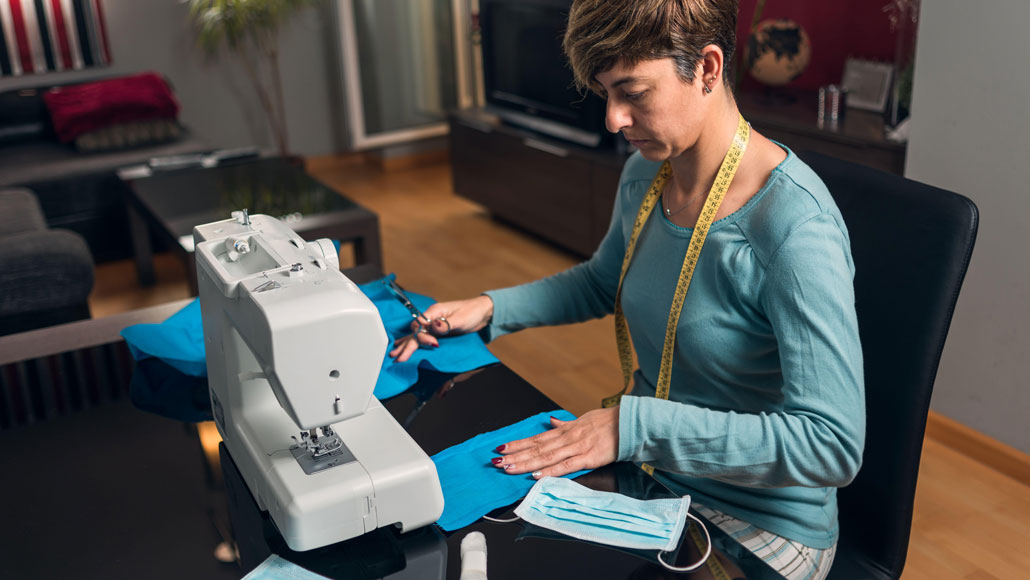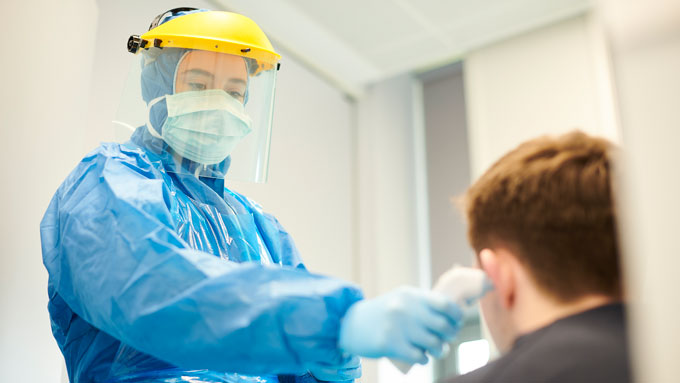Face mask shortages have sparked creative solutions. Will they work?
Health care workers are considering rewearing masks or using homemade ones during the COVID-19 pandemic

In the absence of commercial masks, homemade fabric masks offer limited protection against viruses, including the one that causes COVID-19, experts say.
Rubén Olmo Morales/Alamy Stock Photo
- More than 2 years ago
As COVID-19 sweeps across the United States, hospitals are running out of masks, gowns and eye protection. New supplies aren’t being made fast enough to keep up with demand, and stockpiles seem insufficient.
“There is no bailout,” says David Witt, an infectious disease specialist and epidemiologist at Kaiser Permanente Oakland Medical Center in California. “There is no military supply. There is no national stockpile that will suffice. It’s not coming from another country in aid.”
Mask-making company 3M is ramping up production, and other companies, including Ford, are pitching in. But these efforts will take time. Meanwhile, carpenters, clothing companies and local sewing circles are stepping up to help. Crowdsourcing efforts such as #getmePPE and the 100 Million Mask Challenge are seeking to fill supply gaps in face masks, goggles and other personal protective equipment, or PPE.
An editorial published March 20 in JAMA requested creative ideas. Proposals have flooded in with predominant themes emerging on how to reuse the face masks called N95s, thick, tight-fitting masks that can block tiny virus particles, and how to make alternatives to commercial ones. The innovation on display convinced surgeon Ed Livingston, a coauthor of the editorial and an editor at JAMA, that “this is the biomedical engineering community’s Apollo 13 moment.”
In this fast-moving emergency, it’s unclear which homespun efforts will help the most. Here’s what we know, and don’t know, about how to best conserve the PPE that we have and how to make more.

Trustworthy journalism comes at a price.
Scientists and journalists share a core belief in questioning, observing and verifying to reach the truth. Science News reports on crucial research and discovery across science disciplines. We need your financial support to make it happen – every contribution makes a difference.
Make supplies last longer
Hospitals are asking for donations from anyone who might have PPE on hand, including construction workers, dentists and spa workers. Wearing a single mask for multiple patients is “something that we would normally never do,” Witt says.
Though that practice is not ideal, it might not be terrible. Masks don’t necessarily pick up a lot of contamination, a small study finds. Researchers in Singapore swabbed N95 face masks, goggles and shoes of 30 health care workers as they exited rooms of 15 patients with COVID-19. No viral genetic material was detected, the researchers report March 26 in Infection Control & Hospital Epidemiology, suggesting that extended use of masks and goggles might work, in certain conditions. The study might have missed some virus on masks due to the limited way researchers tested the masks. And the patients were in isolation rooms with 12 air exchanges per hour. Conditions differ at other health care facilities.
Assuming reused masks are bound to get some level of contamination, others have been exploring how to best disinfect masks. Time is a powerful disinfectant; infectivity of SARS-CoV-2, the virus responsible for the COVID-19 illness, plummets after two to three days on hard surfaces. The virus lasts even less time on other surfaces (SN: 3/4/20). Some researchers have recommended rotating through a series of masks, so that worn masks can “rest” and passively become virus-free again.
Other suggestions include heat, chemical disinfectants and ultraviolet light. At the University of Nebraska Medical Center, health care workers hang up strings of used masks in a room with two UV light towers. After a treatment of about five minutes, the masks are ready to be used again. The approach is experimental, and it’s not clear whether multiple rounds of UV light damages the masks.

Make masks at home
The U.S. Centers for Disease Control and Prevention’s new crisis guidelines to health care workers says that where no face masks are available, homemade masks, made of bandannas or scarves, for instance, can be used as a last resort.“That’s how desperate they are, that they said that,” Livingston says.
Cloth masks aren’t ideal. A 2015 study of over 1,000 healthcare workers in Hanoi, Vietnam, found that those who were assigned to wear cloth masks were more likely to get a respiratory virus than those who wore medical masks, made of thick fibers that catch a range of particles. That study appeared in BMJ Open.
Still, homemade cloth masks are better than nothing. “Is it as good as [masks from] medical grade, quality-controlled, assured storage, temperature-controlled warehouse? Probably not,” Witt says. “Is it good enough? Absolutely.” A 2008 study of homemade cloth masks worn by members of the general public, published in PLOS ONE, backs that up, finding that though imperfect, homemade masks can offer some protection against viral particles.
The mask needs to strike a balance between filtering capabilities and breathability. Some materials, such as vacuum bags, are better at filtering than others, a 2013 study in Disaster Medicine and Public Health Preparedness suggests. But vacuum bags are hard to breathe through. Cotton T-shirts offer a breathable fabric that filtered microorganisms roughly half as well as a surgical masks in those experiments.
Other work-arounds focus on 3-D printing, which can churn out hard, clear face shields that protect health care workers’ eyes and possibly extend the life of face masks. That’s what the Qualcomm Institute at the University of California, San Diego is attempting to do. “Improvised visors with some 3D-printed parts seem the most feasible,” say engineer Ramesh Rao, the institute’s director.
Get creative
In response to the JAMA editorial’s call for ideas, several health care workers suggested scuba masks. They’re durable enough to be sterilized, they protect the eyes, nose and mouth, and best of all, they channel air through a small tube that a filter can be placed in. “Why not?” Livingston says. “It makes sense.”
Livingston and colleagues are digging through the ideas, talking with experts and hoping to update people with guidance soon. But for now, “I don’t think anyone can say what’s right or wrong,” he says. “People need to do their best.”
Sign up for our newsletter
We summarize the week's scientific breakthroughs every Thursday.







